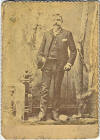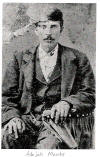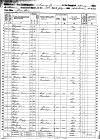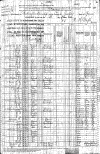|
Private Samuel MardisCompany B Fifteenth RegimentIowa Volunteer Infantry
Researched and compiled by Robert B Sanderson Genealogical research by Jean Hurst
Click on page title to go to that page
Personal Memoir
Click on images to view - files are large and may be slow loading Use browsers back button to return to this page
Summary
The best record we were able to find as to the birth date and place of Samuel Mardis was the record in the 1856 Iowa Census which shows a birth date of 1831-32 because the Census indicates an age in 1856 of 24. A phone call to the Bureau of Vital Statistics of Pennsylvania told us the birth records in Pennsylvania do not go back beyond 1860.
The 1856 Iowa Census shows Samuel Mardis living with his 23 year old wife Meariah Jane and his one year old daughter Violet on a farm in Clear Creek Township, Jasper County Iowa. Meariah was born in Ohio and Violet was born in Illinois according to the Iowa Census.
A search of the 1860 Federal Census and the 1860 Iowa Census failed to disclose the name of Samuel Mardis.
Some time between 1856 and January 1862 Samuel Mardis located in Agency Prairie, Lee Township, Polk County, Iowa. The records indicate that Samuel Mardis volunteered for Army service while living in Agency Prairie with his wife and, at that time, five children. Their sixth child, Samuel T. Mardis, was born October 23, 1862 several months after his fathers death on June 1, 1862.
On January 20, 1862 he enlisted in the United States Army as a volunteer in the Fifteenth Regiment of Iowa Volunteers for a period of three years. He was assigned to Company B under the command of Captain Wilson T. Smith.
The assembled volunteers of the Fifteenth Regiment traveled from Des Moines, Iowa, to Keokuk, Iowa, some time between January 20, 1862 and February 13, 1862 where they were fully mustered into service by February 13, 1862.
The Fifteenth Regiment drilled in Keokuk but had not been issued muskets. They studied tactics and Army regulations. A large majority of officers and men were without military experience. The drilling lasted until March 9, 1862.
On a gloomy day, with rain at intervals coming down freely, the Regiment departed from Keokuk on the Steamer Jennie Deans at 4:00 PM March 19, 1862. They arrived at St Louis, Missouri on March 20, 1862 disembarked and marched to Benton Barracks near St Louis.
The Regiment stayed at Benton Barracks until April 1, 1862 at which date they marched back to St Louis to board a steamer for Tennessee. It was not until they were in training at Benton Barracks that the officers and men were issued arms, accoutrements and general equipment. Ammunition was not issued.
On April 1, 1862 the Regiment embarked on the steamer Minnehaha at St Louis on the Mississippi river. They spent April 1, 2, 3, 4 and 5 going down river to the mouth of the Tennessee river where it meets the Ohio and up the Tennessee river to Pittsburgh Landing, Tennessee, arriving there early on the morning of April 6, 1862 which was the first day of fighting at Shiloh, Tennessee, quite close to Pittsburgh Landing. The actual fighting started at about 6 AM April 6, 1862 with a massed Confederate charge.
The Fifteenth Regiment disembarked at Pittsburgh Landing on Sunday April 6th. They were issued ammunition for the first time and for the first time loaded their guns and engaged the Confederate forces at about 10 AM April 6, 1862.
A detailed description of the Battle of Shiloh is a part of the material included in this booklet. The battle was the largest to occur in the Civil War up to that time. A capsule description of the battle extracted from the material is quoted --
"The peculiar horror of Shiloh-the biggest battle in the nation's history up to that time - lay in the fact that it was simply a fight between two untrained mobs of armed boys. It is estimated that fully 80 percent of the 77,000 men engaged had never before heard a gun fired in anger: a sizable number did not even know how to work their rifles." "Some 23,000 men had been shot or captured"
The Battle at Shiloh lasted only two days--April 6th and 7th, Sunday and Monday, 1862.
Samuel Mardis fought both days and was with his Company B somewhere between Pittsburgh Landing, Tennessee and Corinth, Mississippi when he took ill with the mumps.
The disease was fatal. He died of the disease on June 1, 1862 on Hospital Steamer somewhere between Pittsburgh Landing and St Louis, Missouri. The exact burial place could not be determined He was 29 years old.
Letter to The Des Moines Register August 10, 1994
8/10/94 Letters The Des Moines Register Box 957 Des Moines, Iowa 50304
Dear Letters:
Richard Doak's 8/10/94 essay/comment "Iowa's Civil War veterans" probed into the question as to why so many Iowa young men enlisted during 1862 as volunteers in a civil war that seemed then so far away from the farms and towns of Iowa---a question that has bothered me since researching the Civil War history of my deceased wife's (Marjorie Eleanor Conway Sanderson) great grandfather Samuel Mardis who enlisted January 1, 1862 in Company B of the 15th Regiment of Iowa Volunteers.
An amazing facet of his enlistment was that he and his wife had five very small children and from all that I can gather they were "dirt poor". And, they had one child born nine months after his enlistment. So, here you have a family man of poor means almost overnight pulling up stakes to leave his wife and family of 5 (and one on the way) to eke out some sort of existence during his three year enlistment.
The plight of the mother and wife is highlighted by the family story surrounding the enlistment that goes like this.
Samuel Mardis went to town alone one day and while there was confronted by uniformed "enlistment" soldiers who's purpose was to fill the quotas mandated by President Lincoln to the state of Iowa. Speeches were made and bands played patriotic marches and appeals were made to the able bodied men in attendance to do their duty and step forward to defend their country----the pressure was too much for Samuel Mardis and he stepped forward and signed on.
He soon had to break the news to his wife Maria J. Mardis and at that point he met violent opposition. Maria was stunned and quickly took Samuel and went back to town to confront the authorities and demand that the whole thing be undone. Any undoing they would not do so this young husband and father of 5 said good-by and left to "do his duty" for his country. He enlisted 1/20/1862 fought in the battle of Shiloh contacted the mumps in the days following the battle and died June 1, 1862 on a hospital boat near the Shiloh battlefield at Pittsburgh Landing.
Maria J. Mardis never remarried and did not start receiving any funds from the government until June 1, 1863. In the meantime four of the older children were sent to the Orphans Home in Davenport, Iowa because the monthly pension was only $8.00. She took the children out of the orphanage in 1868 when her appeal to the government gave her an additional $2.00 per month for each of the four older children.
To my mind Samuel Mardis is a hero of the Civil War and to be remembered with honor. BUT, equally so and with even more compassion should we remember Maria Mardis--wife, mother and Civil War survivor....her commitment to the preservation of her family is just as memorable as her husband's commitment to his country.
Robert B. Sanderson
~ Transcriber's note: additional research has revealed a second marriage for Maria Jane Larison Mardis. See Widow's Pension Records and census images for more information. Sources
The majority of the material in this booklet was obtained on August 10, 11, 12 1988 from the Iowa Historical Library in Des Moines, Iowa.
Some materials were obtained from the National Archives in Washington, D. C. - military records pertaining to Samuel Mardis and Federal pension records pertaining to pensions paid to the widow and to the six children.
The book The American Heritage Picture History of The Civil War was obtained from the Public Library, West Des Moines, Iowa.
The United States map depicting the location of the Civil War battles was taken from the novel FREEDOM written by William Safire published 1987.
The photographs included in the booklet were taken October 1988 by Robert and Marjorie Sanderson during their trip to the National Cemetery and Park of Shiloh which includes the National Cemetery and also Pittsburgh Landing and the various battlegrounds and monuments.
Images
Click on image for larger view, then use your browsers back button to return to this page
|
|||||||||||||||||||||||
|
Last Updated: 22 September 2009 |
|||||||||||||||||||||||

















